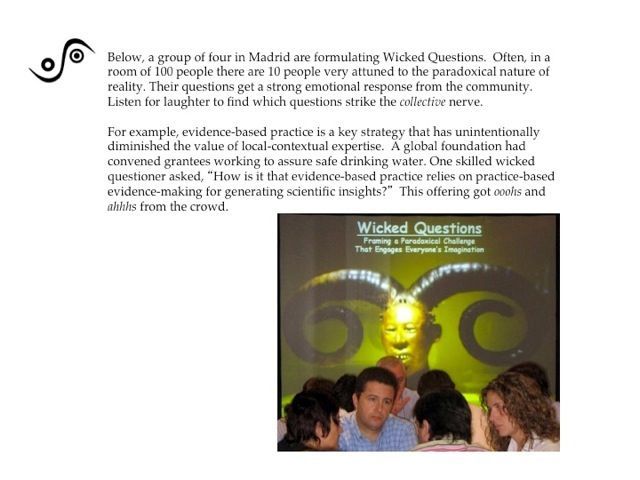![]()
Wicked Questions
Articulate the Paradoxical Challenges That a Group Must Confront to Succeed (25 min.)
How wonderful that we have met with a paradox. Now we have some hope of making progress. – Niels Bohr
What is made possible? You can spark innovative action while diminishing “yes, but…” and “either-or” thinking. Wicked Questions engage everyone in sharper strategic thinking by revealing entangled challenges and possibilities that are not intuitively obvious. They bring to light paradoxical-yet-complementary forces that are constantly influencing behaviors and that are particularly important during change efforts. Wicked Questions make it possible to expose safely the tension between espoused strategies and on-the-ground circumstances and to discover the valuable strategies that lie deeply hidden in paradoxical waters.
Five Structural Elements – Min Specs
1. Structuring Invitation
- Ask, “What opposing-yet-complementary strategies do we need to pursue simultaneously in order to be successful?”
2. How Space Is Arranged and Materials Needed
- Groups of 4 to 6 chairs with or without small round tables
- Paper for recording
3. How Participation Is Distributed
- Everyone involved in the work or topic is included
- Everyone has an equal opportunity to contribute
4. How Groups Are Configured
- Individually
- Small groups (6 people or smaller)
- Whole group
5. Sequence of Steps and Time Allocation
- Introduce the concept of Wicked Questions and paradox. Illustrate with a couple of examples of Wicked Questions. Give the following template, “How is it that we are … and we are … simultaneously?” as the sentence to complete by inserting the two opposite strategies that are at play. 5 min.
- First alone then in small groups, each participant generates pairs of opposites or paradoxes at play in his or her work using the Wicked Question format. 5 min.
- Each group selects its most impactful and wicked Wicked Question. All selected Wicked Questions are shared with the whole group. 5 min.
- Whole group picks out the most powerful ones and further refines the Wicked Questions. 10 min.
WHY? Purposes
- Describe the messy reality of the situation while engaging collective imagination
- Develop innovative strategies to move forward
- Avoid wild or “bipolar” swings in policy and action
- Evaluate decisions: Are we advancing one side or the other or attending to both?
- Ignite creative tension, promoting more freedom and accountability as the discovery process unfolds
Tips and Traps
- Make sure that participants express both sides of the paradox in an appreciative form: “How is it that we are ____ and we are ____ simultaneously?” and not in opposition of each other
- Use a variety of examples to make the paradoxical attributes accessible
- Work in quick cycles, failing forward as you make the questions perfectly wicked
- Avoid nasty questions that appoint blame or are unbalanced on one side. Here is an example of a nasty question: “How can we focus on our customers when we are forced to spend more and more time on the headquarters’ bureaucracy?”
- Avoid data questions that can be answered with more analysis
- Invite participants to include others in making their questions more wicked
- Draw on field experience; ask, “When have you noticed these two things to be true at the same time?”
- There are no quick fixes to Wicked Questions and you may need to return to the challenge periodically with additional rounds of Wicked Questions
- Often a handful of people are very skilled at generating Wicked Questions: let them shine and inspire the rest of the group!
Riffs and Variations
- Use Wicked Questions to evaluate and launch Improv Prototyping, Ecocycle, and 25/10 Crowd Sourcing
- When you have a strong Wicked Question, don’t stop there! Follow with 15% Solutions and 1-2-4-All to generate and sift ideas. Making progress on any one Wicked Question can shift what is possible.
- Learn more from Brenda Zimmerman in Edgeware and
Examples
- For parenting advice: “How is it that you are raising your children to be very loyal/attached to the family and very independent individuals simultaneously?”
- For helping leaders discover how to include everyone in stopping infections: “As infection-control leaders, how is that you have stepped up and stepped back to help a unit take more ownership of prevention practices?”
- For managing large global operations: “How is that we are always and never the same… an organization with a singular global identity and we are uniquely adapted to each local setting? How is it that we are integrated and autonomous?”
- For a functional department, such as HR, finance, legal, etc., to bring to light the Wicked Questions that capture the essence of the function in the context of the department’s organization
- For surfacing personal Wicked Questions, for instance, with respect to one’s relationship to one other person or in connection to a personal challenge. For instance, “How is it that I am simultaneously dedicated to my work and being fully present for my family?”
Attribution: Liberating Structure developed by Henri Lipmanowicz and Keith McCandless. Inspired by professors Brenda Zimmerman (see Edgeware) and Scott Kelso (see The Complementary Nature).
Collateral Material
 Above: Developing Wicked Questions in Madrid
Above: Developing Wicked Questions in Madrid
